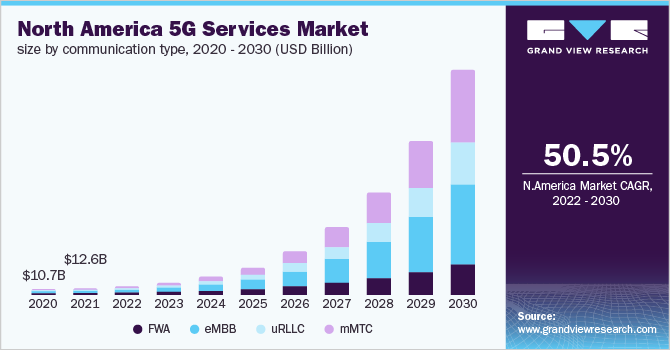The global 5G services market was valued at USD 84.31 billion in 2023 and is anticipated to grow at an impressive compound annual growth rate (CAGR) of 59.4% from 2023 to 2030. The introduction of 5G wireless mobile services facilitates a fully mobile and interconnected environment, offering a diverse array of use cases and business models for consumers. The remarkable data speeds and extremely low latency characteristic of 5G technology significantly enhance the user experience across various applications, including Virtual Reality (VR) and Augmented Reality (AR) gaming, seamless video calls, and Ultra-High Definition (UHD) video streaming, among others.
The increasing demand for high-speed data connectivity, particularly for unified Internet of Things (IoT) applications such as smart home energy management systems, is expected to drive the widespread adoption of 5G services throughout the forecast period. Additionally, there is a growing trend of 5G system integration providers forming partnerships with telecom operators, which is likely to further boost the adoption of these services.
Gather more insights about the market drivers, restrains and growth of the 5G Services Market

Many industry sectors are actively pursuing technological transformations, participating in 5G forums for information sharing, and striving to improve their overall productivity and operational efficiency. This is a strategic move to remain competitive in a rapidly evolving market landscape. The capabilities of 5G technology are poised to facilitate significant transformations across various sectors by reducing overall costs and enhancing productivity.
Moreover, there is a continued focus on improving energy monitoring and management. Achieving better control over the energy generation and distribution networks is expected to play a vital role in driving market growth during the forecast period. As industries increasingly adopt 5G technology, the potential for improved energy management and operational efficiencies will likely contribute to the expansion of the market.
Communication Type Segmentation Insights
The Enhanced Mobile Broadband (eMBB) segment dominated the market in 2022, capturing more than 40% of the overall share. This significant proportion is primarily due to the initial focus of 5G network operators on delivering advanced broadband capabilities tailored for various applications. These applications include high-speed cloud-based gaming, augmented and virtual reality (AR/VR), Ultra High Definition (UHD) video streaming, and uninterrupted video calls. During the initial rollout phase, the emphasis is expected to be on a 5G wireless non-standalone deployment model, which enables operators to provide robust broadband services more efficiently.
eMBB is designed to offer exceptionally high data speeds, making it suitable for both residential and commercial use. As a result, it is anticipated to support a wide array of use cases, such as in-vehicle infotainment systems, access to 4K video content, and virtual meetings. This versatility in application is a key driver of growth for the eMBB segment.
On the other hand, the Massive Machine-Type Communications (mMTC) segment is projected to experience the fastest compound annual growth rate (CAGR) from 2023 to 2030. mMTC aims to address the increasing demand for a sophisticated digital ecosystem. This segment is specifically focused on providing services for applications that require high connection density, such as smart buildings and smart cities. As the need for seamless connectivity among numerous Internet of Things (IoT) devices deployed within various networks continues to grow, it is expected to significantly boost the mMTC segment's expansion throughout the forecast period.
Order a free sample PDF of the Market Intelligence Study, published by Grand View Research